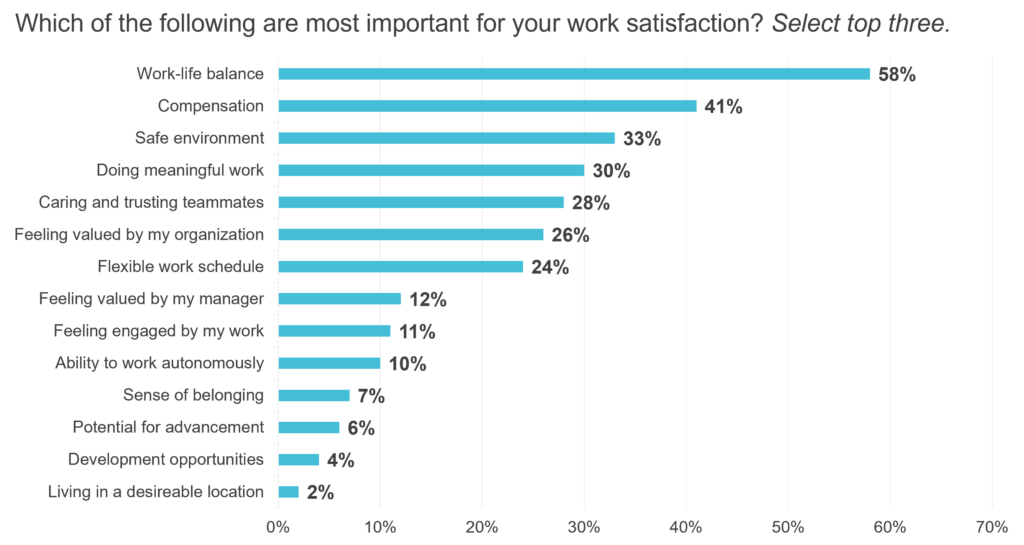Melissa Kozak
Oct 12 2023
Melissa Kozak
Oct 12 2023
Reading Time: 6 minutes
There’s no doubt about it – your staff of nurses, CNAs, social workers and other clinicians is by far your No. 1 asset. And that’s why the recent healthcare stats are so important for home-based providers to not only pay attention to but also act on. Let’s take a look.
A shortage of 3.2 million healthcare workers is predicted by 2026 (Advisory Board: 2022 Digital Health Trends). The median turnover rate in home care was 77% for 2022 (HCP 2023 benchmarking report). Half a million employees left their healthcare jobs in each month of 2022 (U.S. Bureau of Labor Statistics). And when it comes to nurses, 22% intend to leave their jobs this year (Advisory Board: 2022 Digital Health Trends) – with 61% under 35 reporting they felt anxious in the past 2 weeks and 33% saying they felt depressed (American Nurses Foundation: Three-Year Annual Assessment Survey).
Clinician burnout and turnover is an expensive business issue that goes beyond the expected direct costs of hiring and training new employees. In fact, the indirect costs of clinician attrition and burnout can significantly impact your organization by increasing the workload for your current team, reducing the quality of care of your patients, and lowering both productivity and morale, all of which show up in CAHPS scores and patient outcomes.
But while these stats can be alarming – especially when coupled with an already substantial nursing shortage and rising volume of patients – the right technology tools can make a difference in helping you significantly reduce the burden on clinicians to boost their satisfaction and retention. Here are 5 ways.
Improve team communication and collaboration.
I was a nurse in the field for many years where we spent a lot of time piecing the patient’s story together from the previous visit. That fragmented communication causes frustration and extra workload for clinicians as well as delays in patients getting the care they need. Now there are technology tools available to give your entire care team real-time access to all communication regarding a patient – including up-to-the minute nursing notes and care plans – so they can get up to speed on a patient’s status within minutes of arriving at a patient’s home.
CitusHealth’s patient discussion groups (PDGs) are an ideal way to capture and curate patient information in one place. A PDG is a customizable chat thread for a single patient that keeps conversations about care in one location to give all those involved in providing that care an up-to-date view of care progress and needs. Learn more about PDGs.
Reduce administrative burdens.
One of our customers made the comment, “I can tell you none of my colleagues went to nursing school to run papers around,” and I’m sure that resonates with all of us. Administrative tasks drain your team of time and effort, but it doesn’t have to be that way. With the use of technology, you can empower your clinicians to work at the top of their licenses by reducing those administrative burdens we all dread like making multiple phone calls and voicemails to coordinate or confirm a visit, transferring signed paper documents from the patient’s home to the office by car or fax, and entrying data multiple times into different systems.
Support work-life balance.

58% of nurses cite work-life balance as the most important element for work satisfaction (American Nurses Foundation: Three-Year Annual Assessment). This is one stat that didn’t surprise me because I’ve been there, done that, like you, with a laptop on my lap at home charting or completing other time-consuming paperwork after hours. So what can be done to stop stretching nurses and other clinciains past their limit? With today’s technology, for example, nursing documentation can be done digitally while in the patient’s home, reviewed by the nurse manager and sent back to the nurse for quick editing. That way, when the work day is done, so is your care team – leading to a healthy work-life balance and far less clinician burnout.
Streamline and automate commonly used workflows.
We all know that there are plenty of workflows with too many steps, draining your care team of time and effort. But digital technology can help streamline and automate your commonly used workflows – like welcome packets and admission paperwork, signature capture from patients, POAs and physicians, and data collection for patient satisfaction and assesstments – to give your care team more time doing what they do best: helping patients. Even workflows that involve patient care like swelling assessments can be streamlined to cut out drive time to a patient’s house using secure video chat.
Learn more about five commonly used communication workflows.
1. Secure messaging from patients
2. Internal staff comminication and collaboration
3. Delivery coordination
4. Scheduling coordination
5. Medication or therapy tolerance check-ins
Utilize integrated software that’s easy to use.
One of the biggest concerns I hear from home-based care providers is how busy they are because they’re understaffed. Trying to address those issues, of course, is a double-edged sword because where do you find the time to learn how to use new software without burdening your already overworked staff. That’s why it’s a top priority for you to choose integrated, easy-to-use software that focuses on interoperability, training and ongoing support. As a result, you can eliminate duplicate workflows and unnecessary administrative work to reduce staff burnout while boosting their satisfaction.

Now that we’ve reached a tipping point in home-based care due to clinician attrition and burnout, it’s more important than ever to find ways to protect your No. 1 asset – your staff. Instead of continuing to ask them to do more with less or overloading them with administrative burdens that lead to greater frustration and less motivation, providers can take steps to make them happier in their roles. And that starts with easy-to-use software tools that support commonly used workflows, care plan collaboration, task reduction – and most importantly — a healthy work-life balance for increased satisfaction and retention of your greatest asset.